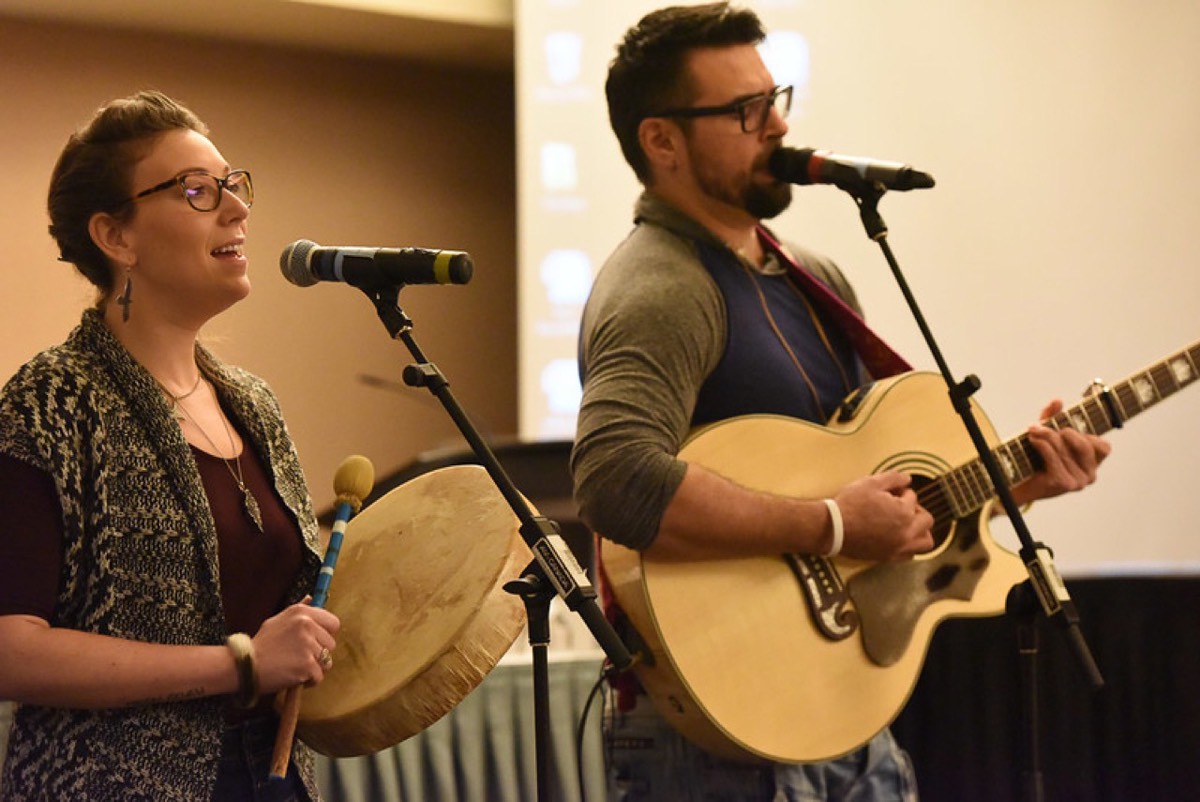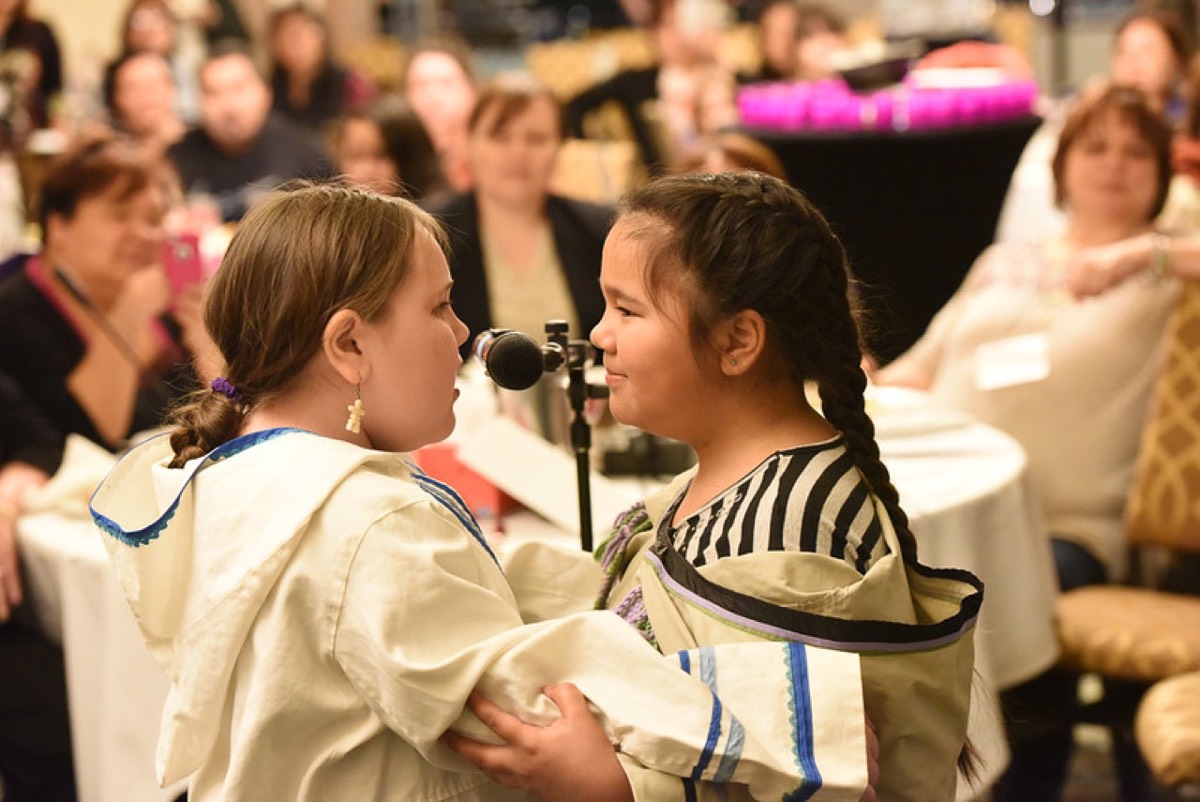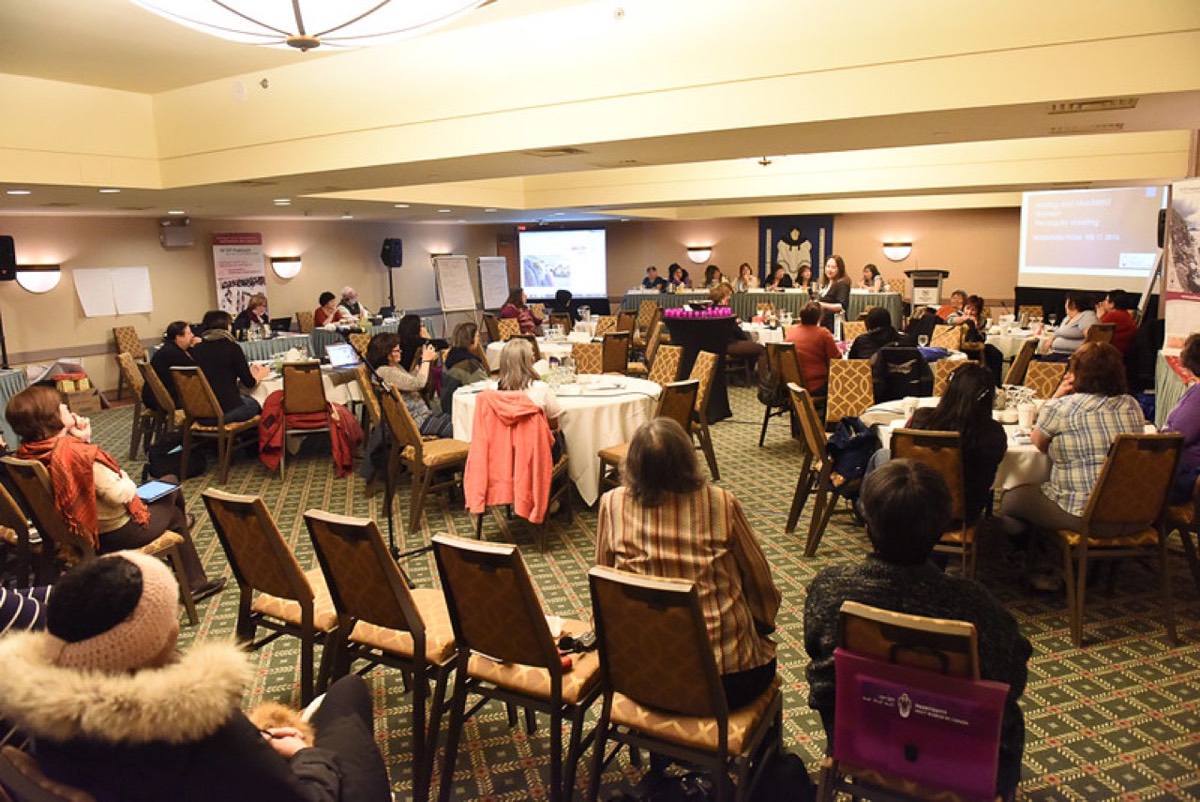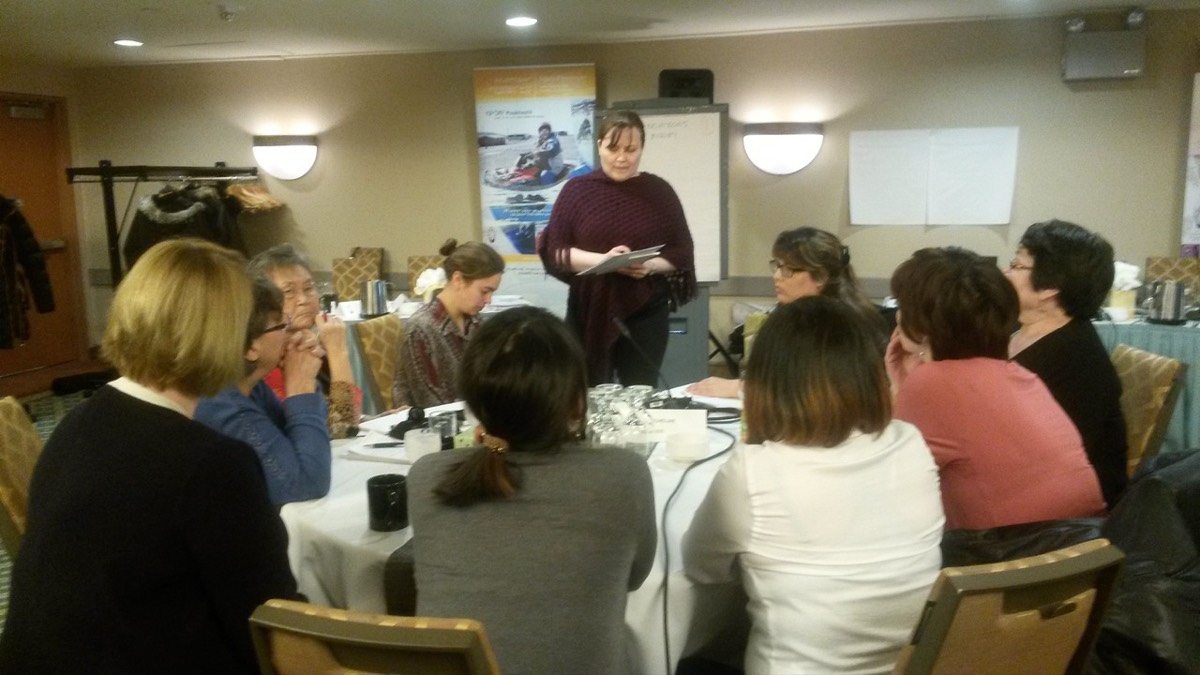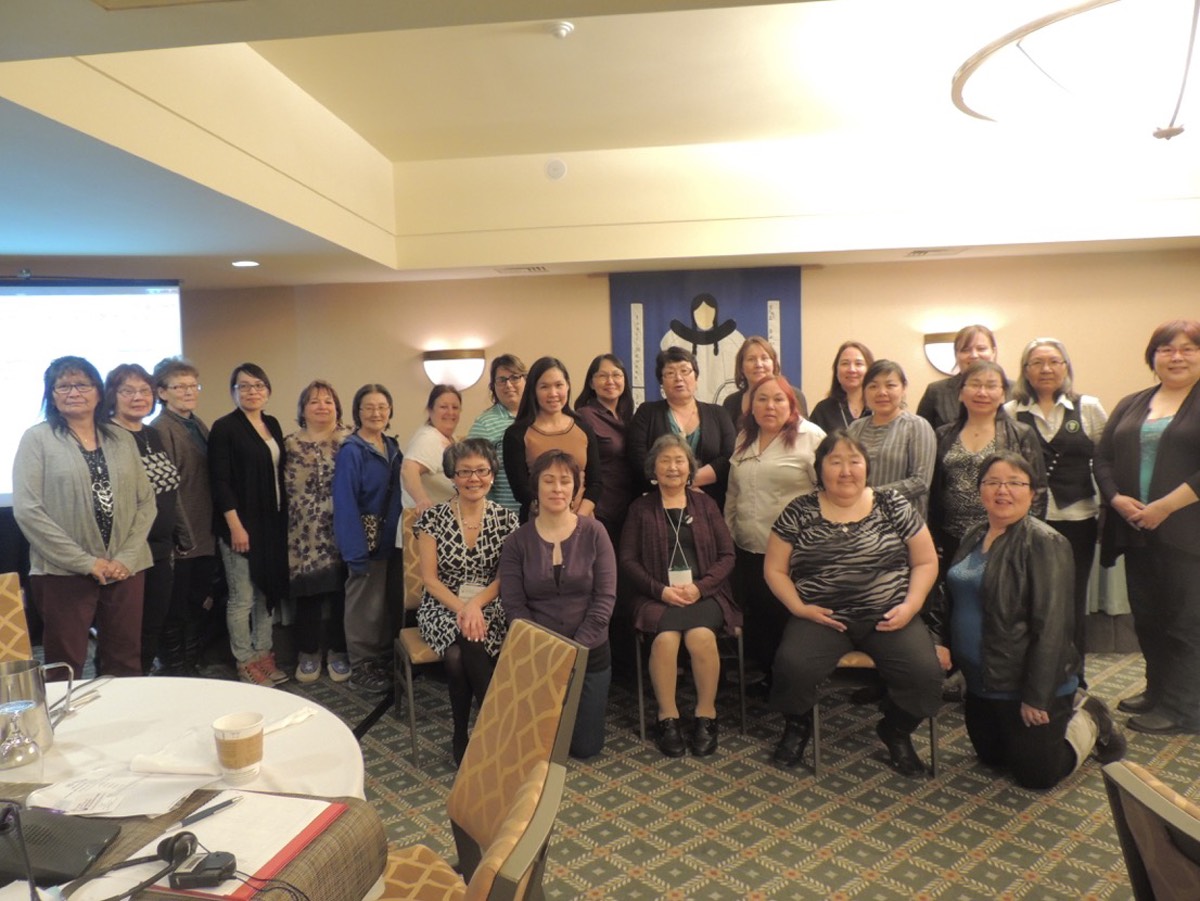
Publications
Play audio
MMIWG Calls for Justice
What Does Co-Development Mean to Inuit Women?
Report in Brief – April 2020
To ensure effective and relevant implementation of the Calls to Justice for Inuit, Inuit women must have active participation in developing an agreement with the federal government about what co-development will entail.
There is a need to move beyond how the federal government interprets the term “co-development” and clearly define our expectations as a full partner in the process. There must be consultation between the parties (Inuit women and the federal government) on the issues and the development and analysis of solutions a view to reaching mutually agreed to solutions. The National Action Plan to Address Missing and Murdered Inuit Women and Girls must meet the unique priorities, needs and circumstances of Inuit women and girls, as well as binding for monitoring and accountability.
Pauktuutit Co-Development Engagement: Overarching Recommendations
In January, 2020, Pauktuutit held a two-day national engagement session with approximately 50 participants, government observers and other experts.
Participants endorsed by consensus the following guiding principles.
- A human rights framework as the basis for co-development
- Consistent with the articles of the UN Declaration on the Rights of Indigenous Peoples including free, prior, informed consent
- Recognition and inclusion of the diversity of Inuit women, including those residing out of Inuit Nunangat and hard-to-reach individuals
- Address long standing gaps and meet future needs
o Shared objectives with clear decision making - Clear understanding of and agreement on respective roles and responsibilities
- Inuit women as co-chairs
- Accountability mechanisms, measures and transparency
- Clear expectations for the process and outcomes
- Realistic timelines
- Adequate resources for participation
- Ongoing dialogue and communication
- Monitoring implementation
- Scope and capacity
- Relevant partners and stakeholders as identified by Inuit women.
It was further noted that co-development of a National Action Plan for MMIWG must also be rooted in Inuit Qaujimajatuqangit:
- Inuuqatigiitsiarniq: respecting other, relationships and caring for people
- Tunnganarniq: fostering good spirit by being open, welcoming and inclusive
- Pijitsirniq: serving and providing for family and/or community
- Aajiiqatigiinniq: decision making through discussion and consensus
- Pilimmaksarniq: development of skill through practice, effort and action
- Piliriqatigiinniq/Ikajuqtigiinniq: working together for a common cause
- Qanuqtuurniq: being innovative and resourceful in seeking solutions
- Avatittinnik Kamatsiarniq: respect and care for the land, animals and the environment
Specific examples are included below:
- Piliriqatigiinniq/Ikajuqtigiinniq A co-development process where all participants are working together toward a common objective will support the opportunity to produce better outcomes. (better than one that results from unilateral action).
- Inuuqatigiitsiarniq All parties participate on an equal basis with equal capacity, expertise and with equal opportunity to influence the process and outcomes.
- Aajiiqatigiinniq Decisions are made by consensus. Checking back with each other on a regular basis ensures ongoing engagement and commitment and reinforces trust.
- Pilimmaksarniq/ Pijariuqsarniq A good co-development process allows participants to continually learn from each other.
- Qanuqtuurniq The process must be flexible to enable maximum creativity and relationship building.
- Pijitsirniq Advocacy by not only Pauktuutit and our fellow Inuit women, but also with the federal government, results in a strong commitment to promote the co-development plan and a greater likelihood of buy-in and acceptance during the implementation phase.
Upon agreement and shared understanding by all parties for a well-defined framework for co-development and with common components, there will also be a need to identify and address unique and specific considerations for each region.
These are anticipated to include but not be limited to:
- Timelines that address the size of the region, remoteness, accessibility and availability of those who need to be engaged, seasonal considerations such as weather and traditional activities.
- Scope and size of the project, consultation/engagement plans, etc.
- Resources may include space, equipment, human resource capacity, housing and accommodations, transportation, translation, research and reporting requirements?
- Partners/stakeholders including key informants, project leads, local and regional governments, others: “The right people must be at the table.”
- Other requirements as determined by each region.
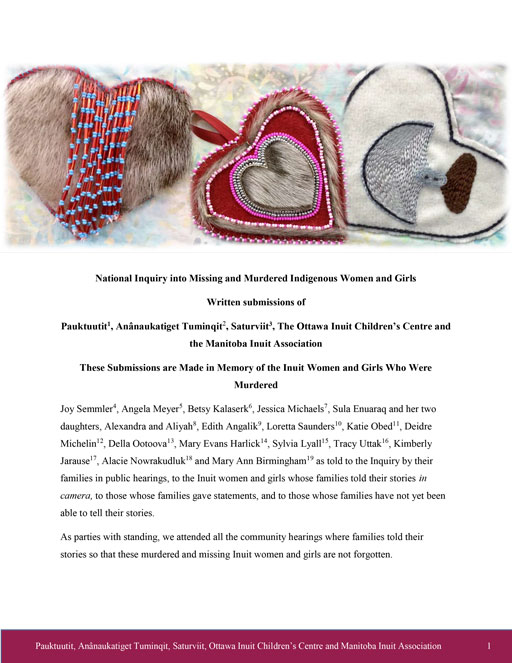
Written submissions
These Submissions are Made in Memory of the Inuit Women and Girls Who Were Murdered.

Oral submissions
These Submissions are Made in Memory of the Inuit Women and Girls Who Were Murdered.
Nipimit Nanisiniq – Finding Voice
The issue of missing and murdered Indigenous women and girls has generated national and international attention and concern over a number of years, and now the federal government will be holding a National Inquiry on the matter. Pauktuutit, with the support of Minister Carolyn Bennett and officials at Indigenous and Northern Affairs Canada, held a four day pre-consultation meeting in Ottawa in February 2016 that brought together Inuit family members, representatives of a number of regional and national Inuit organizations, subject matter experts and others. This unprecedented meeting resulted in a comprehensive report with many recommendations on the mandate, composition, scope and process of the national inquiry. Participants also gave a name to the work to come: Nipimit Nanisiniq Finding Voice.
Pauktuutit has long called for immediate actions that are needed now. This meeting also finalized a national strategy for the prevention of violence against Inuit women and children. This strategic plan is based on recommendations that have been made for decades by bodies including the Royal Commission on Aboriginal Peoples, the Aboriginal Healing Foundation and the Truth and Reconciliation Commission as well as Pauktuutit’s direct consultations with Inuit women over the same period of time.
Pauktuutit’s four-day pre-consultation meeting on the national inquiry on MMIWG allowed time to honour and commemorate those whose lives have been taken, consider the immense questions and concerns of family members and others in relation to the inquiry, and time to look ahead. On the last day of the meeting, participants were joined by Jaaji and Chelsea June of Twin Flames who performed Porchlight, a song written by Jaaji about the issue of missing and murdered loved ones. We hope you will also enjoy this profile of Twin Flames, as well as Porchlight, as a tribute to all those who motivate and support this important work.
These links will take you to relevant information about the National Inquiry into Missing and Murdered Indigenous Women and Girls and other information.
Photo Gallery
Discussion Questions About the national inquiry into missing and murdered indigenous women and girls
The Government of Canada wants to know how we think the Inquiry should be set up. It would like us to answer these questions.
-
Who should lead the Inquiry?
Inquiries can be set up in different ways. On the other sheet (What is an Inquiry?) you will find examples of different kinds of Inquiries. Which one would work best for Inuit? We can also come up with something completely new.
What kind of person should lead the Inquiry? A judge, lawyer, member of an Indigenous organization, or respected community leader? Should it be more than one person? Men, women or both? How should families be involved formally?
Are there Inuit women who would make good commissioners for an Inquiry on missing and murdered Indigenous women?
-
Who do you think should provide views or have an opportunity to participate in the Inquiry?
Should everyone who wants to be allowed to talk at the Inquiry gatherings? This might include all family members and anyone with an opinion.
Should some people be invited or asked to talk with the commissioners? Apart from family members and Indigenous groups, there might be agencies that could be questioned about their role in helping or harming Indigenous women, like police, child welfare/social services, health systems, community leaders, and federal, provincial and territorial governments.
(Question 7 is about how Indigenous groups should be involved in the Inquiry.)
-
What are the key issues that need to be addressed by the Inquiry?
The Inquiry is going to need to look at anything that has to do with why Indigenous women are more likely than other women to go missing, die or be victims of violence. What do you think this includes?
- Inter-generational trauma? Impacts of Residential Schools? How loss of control and violence has led to addictions and family violence?
- Factors related to low self-esteem of women?
- Lack of enough Inuit-specific healing services?
- Shelters, safe houses and housing?
- Child sexual abuse and neglect?
- Lack of educational and economic opportunity in many Inuit communities?
- Foster care?
- The criminal justice system (courts), correctional system (jails) and policing?
- Anything else?
-
How can the process be set up so it results in providing concrete and practical recommendations for specific actions?
This means that the government wants more than a report from the Inquiry, it wants recommendations that will actually be acted on.
One of the ways to make practical recommendations that can be acted on is by including people from the organizations that should change. Maybe if people from provincial and territorial governments, the health system, the police, the child welfare system, and so on have a part to play in the Inquiry, they can help make the changes that need to happen. Under the law that the Government of Canada uses to set up Inquiries, it is not allowed to look at anything that is the responsibility of provincial or territorial governments, like policing (except the RCMP), mental health and social services, shelters, housing, and so on, unless the provincial and territorial governments agree. People may be more likely to act on a recommendation if they have been part of the process of making the recommendations.
Another way might be to build in a media strategy to make sure all Canadians know every step of the way what the Inquiry is finding out. This can build public support for the recommendations.
Would these ways be good for Inuit? Are there other ways of setting up the Inquiry that would lead to practical recommendations that the government and others will actually take action on?
-
How can cultural practices and ceremonies be incorporated into the design of the Inquiry?
How can the Inquiry honour Inuit cultural values and practices? Should a qulliq be lit by an elder when the Inquiry comes to Inuit regions, or everywhere? Are there other ceremonies or cultural practices (throat-singing, drumming, traditional games) that should take place? What about in urban areas in which there are many Inuit, but they live on other people’s traditional lands? How should the inquiry respect Inuit and make Inuit welcome at these gatherings?
Should cultural symbols (like an amauti, drum, qulliq, kamiks) be presented to the inquiry at the beginning, so the Inquiry can take the Inuit presence and blessing wherever it goes? If so, is there anything else that could be given? Should these things be returned to Inuit with the Inquiry’s final recommendations, or kept in a special place to commemorate what was heard?
Do you have any other ideas about what the Inquiry can do to honour Inuit, and make Inuit feel safe, welcome and respected?
-
How is it best to involve the families, loved ones and survivors in the Inquiry?
Should families, loved ones and survivors be able to do more than just talk to the Inquiry? If so, what?
Should the Inquiry do something to honour those who are missing or have been killed, and those who have survived?
Should family members be involved in the Inquiry’s decision-making in some way, like have a family member on the Inquiry, or have a family member’s circle to advise the Inquiry?
-
How should Indigenous groups (national Aboriginal organizations, front-line workers, band councils, etc.) be included in the Inquiry?
National Aboriginal organizations (Inuit Tapiriit Kanatami, Assembly of First Nations, Congress of Aboriginal Peoples, Métis National Council and Native Women’s Association of Canada) are already involved in giving the government advice on how the Inquiry should be set up. What role should Pauktuutit play? How else should these organizations be involved? Should they name the commissioners or have a place on the Inquiry itself? Are there other ways they should be included in the Inquiry?
What about Inuit regional governments, regional Inuit women’s organizations, land claims organizations, hamlet councils and front-line workers in communities? How should they be involved in the Inquiry? Should they just speak to the Inquiry like everybody else? Should they play a role in encouraging people to speak to the Inquiry? Should they play a lead role in working with the communities? Is there anything else they can or should do?
-
What supports (health supports, counselling, translation, etc.) may be needed during the Inquiry for individuals who are participating?
The Government of Canada has already set up a crisis line to provide support to people who need it. This line is free and available 24 hours a day, 7 days a week at 1-844-413-6649. What else should the government do to help people participate in the Inquiry?
- Provide counsellors for people testifying? Do these counsellors need to be Inuit elders or healers in Inuit regions and urban areas in which there are many Inuit?
- What about connections to longer-term counselling? Should the Inquiry counsellors help people find ways of ongoing support?
- Should the Inquiry provide interpretation in the dialect of the region?
- Should the Inquiry pay for people’s travel and accommodation, so they can speak with the Inquiry?
- Is there anything else that people might need to help them participate in the Inquiry?
-
Is there anything else you would like to add to help design the Inquiry?
Are there other things that the Inquiry should be or do?
What is an inquiry?
The Government of Canada is setting up a National Inquiry into Missing and Murdered Indigenous Women and Girls.
An Inquiry is a person or a group of people who are given directions, staff and a budget from government to find out about something and make recommendations. They are given terms of reference – which is a written statement about what they are supposed to find out. They are not allowed to look at anything outside of the terms of reference. The government sets the terms of reference, in this case, with input from organizations like Pauktuutit.
The commissioners, who are the people named by government to find out why there are so many missing and murdered Indigenous women and what to do about it, usually decide what information they need, whether they need to do research and on what, who to talk to and how (like public hearings, smaller meetings, written statements). The Government is asking for our advice about this too.
Inquiries often cost a lot of money – salaries for the commissioner(s) and staff, equipment like computers and office space, travel to different areas of Canada, translation, and so on. Since a lot of money will be spent on this, it is important to have an Inquiry that works well for Inuit and that will make recommendations that people will act on.
What an Inquiry can and can’t do
- An Inquiry can only do what is in its terms of reference – nothing more. If it discovers issues that should be looked at but these issues are not in the terms of reference, they can’t look at them. This is what happened in the British Columbia Missing Women Commission of Inquiry. The head of the Inquiry, Wally Oppal, said there were many issues that made Indigenous women more likely than other women to be victims of violence, like social and economic conditions, intergenerational trauma, racism, but he was given the job of just looking at what the police did, and could not look in detail at these root causes. That is why it is important to get the terms of reference right, so that the Inquiry is allowed to look at anything necessary to reduce violence and victimization of Indigenous women.
- The government can give inquiries the power to make some people testify (like government representatives and others). The government can also give the Inquiry the power to ask for documents, and governments and organizations cannot legally refuse. Inquiries can also be set up as task forces, advisory or expert panels, or ombudspersons who can conduct investigations and research, but these Inquiries may not be able to make witnesses testify at hearings or make governments or agencies turn over their documents.
- Inquiries are not trials – they can’t convict anyone or order fines.
- Inquiries can’t force governments or anyone else to act on their recommendations.
How an Inquiry is set up matters
- The Government of Canada is setting up this Inquiry. Under the law, it can’t look at anything that is the responsibility of the provinces and territories, unless the provinces and territories agree to be part of the Inquiry. Provinces and territories are responsible for things like social services, mental and physical health care, child welfare, policing and education. There have been a few joint Inquiries with the federal government and one or more provinces, so it is possible to get provinces and territories to agree to be a part of the process.
- Who is involved in an Inquiry matters. The Inquiry has to be accepted by Indigenous peoples, or people will not trust it enough to come to talk to it. The Inquiry has to be accepted by the rest of Canadian society, or the recommendations may never be acted on.
Examples of Inquiries
There are many different kinds of Inquiries. The Inquiries listed below are in the order of the number of commissioners. A little bit of information is given about each Inquiry, but the information given is not tied to the number of people who are leading the Inquiry. We can “mix and match” the things we like and that work well for Inuit.
- There can be one person leading the Inquiry, and no one else. The Mackenzie Valley Pipeline Inquiry, also known as the Berger Inquiry, in the 1970s, is an example of a one-person inquiry led by a judge, Thomas Berger. Another example is the British Columbia Missing Women Commission of Inquiry led by Wally Oppal from 2010 to 2012.
The Berger Inquiry was really the first of its kind in respecting Indigenous peoples. It held hearings in all 35 communities along the Mackenzie River Valley, and heard evidence from people in their own languages in their home communities, as well as in 10 cities across Canada. Twelve groups became full participants in the Inquiry, attending all meetings and testifying before the commission. The Inquiry’s report, Northern Frontier Northern Homeland, recommended a way to balance environmental, social and development issues and the settlement of Indigenous land claims. It was used for many years by Indigenous groups to argue for their rights and establish land claims.
- There can be several commissioners, but with one commissioner leading the Inquiry. The Truth and Reconciliation Commission (TRC), led by Justice Murray Sinclair, is an example of this. There were two other commissioners, Dr. Marie Wilson and Chief Wilton Littlechild. Dr. Wilson was not Indigenous, but had a family connection to Indigenous peoples. This Inquiry had an Inuit Sub-Commission, to make sure Inuit voices were heard. The Co-Directors of this Sub-Commission Jennifer Hunt-Poitras and Robert Watt held hearings in Inuit regions. The TRC also had an Indian Residential Schools Survivor Committee, 10 people who advised the commission.
The TRC did research and got access to documents which showed what conditions were like in Indian Residential Schools, and heard from many survivors. In its interim report, They Came for the Children, many of these stories are told. The TRC’s closing ceremonies got a lot of media coverage, which helped Canadians in general as well as Indigenous peoples talk about what happened in Residential Schools and how to heal from this. The TRC created the Missing Children Project, which documents the deaths and burial places of children who died while attending an Indian Residential School. The TRC final report, Honouring the Truth, Reconciling for the Future, includes 94 Calls for Action on a broad range of issues – child welfare, education, language and culture, health, justice, church apologies, museums and archives, commemoration, media, sports, business and more. Volume 2 of the TRC’s report is called Canada’s Residential Schools: The Inuit and Northern Experience. It contains many of the voices of Inuit who testified to the TRC, and records their experiences for all time. Some people had never talked about their Residential School experience before, and the TRC gave them a chance to do that. The TRC also did outreach to churches, organizations and the public to become a part of the reconciliation process.
- There can be several commissioners, with two people leading the Inquiry. An example is the Canadian Panel on Violence Against Women. There was one English-speaking co-chair, and one French-speaking co-chair. The nine members of the Panel were mainly people who worked in the area of violence against women as counsellors, researchers or lawyers. This Inquiry had an Aboriginal Circle, which had representatives from Pauktuutit Inuit Women of Canada, Native Women’s Association of Canada and Métis National Council of Women. There was an elder who was a representative of the Assembly of First Nations on the main Panel, and she also participated in the Aboriginal Circle. The Panel released its report in 1993, called Changing the Landscape: Ending Violence, Achieving Equality. This report did not result in many changes, but the Panel did raise awareness across Canada about violence against women. It visited many small communities and there were reports about it on TV, radio and newspapers. Panel members did interviews with the media, talking about what violence against women was and what could be done about it.
Another example of an inquiry with two co-chairs and several commissioners is the Royal Commission on Aboriginal Peoples (RCAP). The Co-Chairs were a judge (René Dussault) and a former Grand Chief of the Assembly of First Nations (Georges Erasmus). There were five other Commissioners, which included Indigenous and non-Indigenous people: Mary Sillett (former president of Pauktuutit and ITK), Paul Chartrand (a Métis lawyer), Peter Meekison (a non-Indigenous professor and former government official), Viola Robinson (a well-respected Mi’kmaq activist) and former Supreme Court Justice Bertha Wilson, who is not Indigenous. A mix of Indigenous and non-Indigenous commissioners can send the message that these are everyone’s issues and all of society is involved in resolving them. In 1996, RCAP wrote a report in five volumes – Looking Forward Looking Back; Restructuring the Relationship; Gathering Strength; Perspectives and Realities; and Renewal: A Twenty-year Commitment which set out 440 recommendations to be implemented over 20 years to rebalance the relationship between Indigenous and non-Indigenous peoples in Canada. Most of these recommendations have not yet been implemented. RCAP did a lot of research that didn’t exist before and set out the whole picture, which also had not been done before. RCAP’s research is still used today, 20 years later.
Qikiqtani Truth Commission: An example of an Inuit-led Inquiry
The Qikiqtani Inuit Association (QIA) and Makivik Corporation called for the federal government to launch a public Inquiry into the killing of qimmiit (sled dogs) between 1950 and 1975. In 2004, QIA began collecting testimony directly from Inuit to better understand how government policies, programs and decisions affected them and their families. People said that the biggest impact was from the loss of qimmiit and relocations into established communities. In 2005, the Government of Canada directed the RCMP to investigate its actions to kill qimmiit between 1950 and 1975. The RCMP wrote a report saying that there was no organized killing of sled dogs by RCMP, and dogs that were killed were sick or dangerous. QIA and Makivik rejected this report, and in 2006 created a truth commission to document what really happened.
The Qikiqtani Truth Commission (QTC) is the first Inuit-sponsored and Inuit-led initiative of its kind. The QTC had one Commissioner – it was led by James Igloliorte. Madeleine Redfern was the Executive Director of the QTC, and she coordinated the Commission’s work. The QTC interviewed 345 witnesses during 16 public hearings, reviewed 131 interviews taped by QIA between 2004 and 2006, and collected a huge number of documents about the relationship between Inuit and government between 1950 and 1975. Through this work, the QTC documented in detail many of the decisions, actions and events that of this period of great upheaval for Inuit. What began as an Inquiry into qimmiit touched on every aspect of Inuit life.
The QTC found that between 1950 and 1975, the Canadian government forced policies and programs onto Inuit without Inuit consultation or consent. Although the government claimed that it was for the own good of Inuit, many of these policies or programs were done either to meet Canadian economic or political desires or were poorly thought out, often mismanaged and/or underfunded. As a result, Inuit experienced cultural, personal, and economic losses during this period which are still being felt and passed on to younger generations.
This Inquiry gave the Inuit who participated a chance to tell their truth, and be respectfully heard. Sometimes just talking about something and having someone listen with concern is very powerful. So is hearing from others who have had a similar experience, which can show you that you are not alone. The QTC recorded the words of many elders for all time. Some of these elders are no longer with us. The QTC findings were presented to government, so the government could know what Inuit thought, felt and experienced.
Glossary
What the words mean
Commissioner can mean the head of the Inquiry if it is led by one person. If there are many people on the Inquiry, then a commissioner is just one of those people.
Hearings are when people come to talk to the Inquiry.
Implementation means taking action on what the Inquiry says to do.
Indigenous means the same as “Aboriginal”, and includes First Nations, Inuit and Métis.
Inquiry is a person or group of people with some staff and money who are given the job of finding something out for the government and making recommendations.
Judicial inquiry is an Inquiry that is led by a judge, like British Columbia’s Missing Women Commission of Inquiry led by Wally Oppal.
Mandate is the job that the government gives the Inquiry. It is what the inquiry is supposed to do.
National Aboriginal Organizations include Inuit Tapiriit Kanatami (ITK), the Assembly of First Nations (representing on-reserve First Nations), Congress of Aboriginal Peoples (representing off-reserve First Nations), the Métis National Council, and the Native Women’s Association of Canada.
Ombudsperson is a person who is given the power by government to hear people’s complaints, usually about government or a government agency, and find a solution.
Preliminary hearings are when the Inquiry hears from people before the main job of the Inquiry starts. Often preliminary hearings are about what the Inquiry should include and how. These hearings help the Inquiry plan its time and work.
Public hearings are when the Inquiry hears from people, and anyone can come.
Recommendations are a list of things that people should do. An Inquiry can make recommendations for government, for organizations, for the public, but no one has to do what the Inquiry recommends.
Scope of the Inquiry is what the Inquiry is supposed to find out. The scope is really meant to tell the Inquiry what issues to focus on and where to stop.
Subpoena (pronounced suh – pee – na) is an order given to answer questions or to hand over documents that must be obeyed by law. Not all Inquiries are given the power to subpoena testimony or documents.
Task force is a group of people who are put together for a period of time to carry out a specific project. A government task force is the same as an Inquiry, except that it may not have the power to force people to testify or insist on getting documents.
Terms of reference is a written statement about exactly what the Inquiry should be doing. The Inquiry should not do anything that is not in the terms of reference.
Testify means saying what happened and answering questions.

